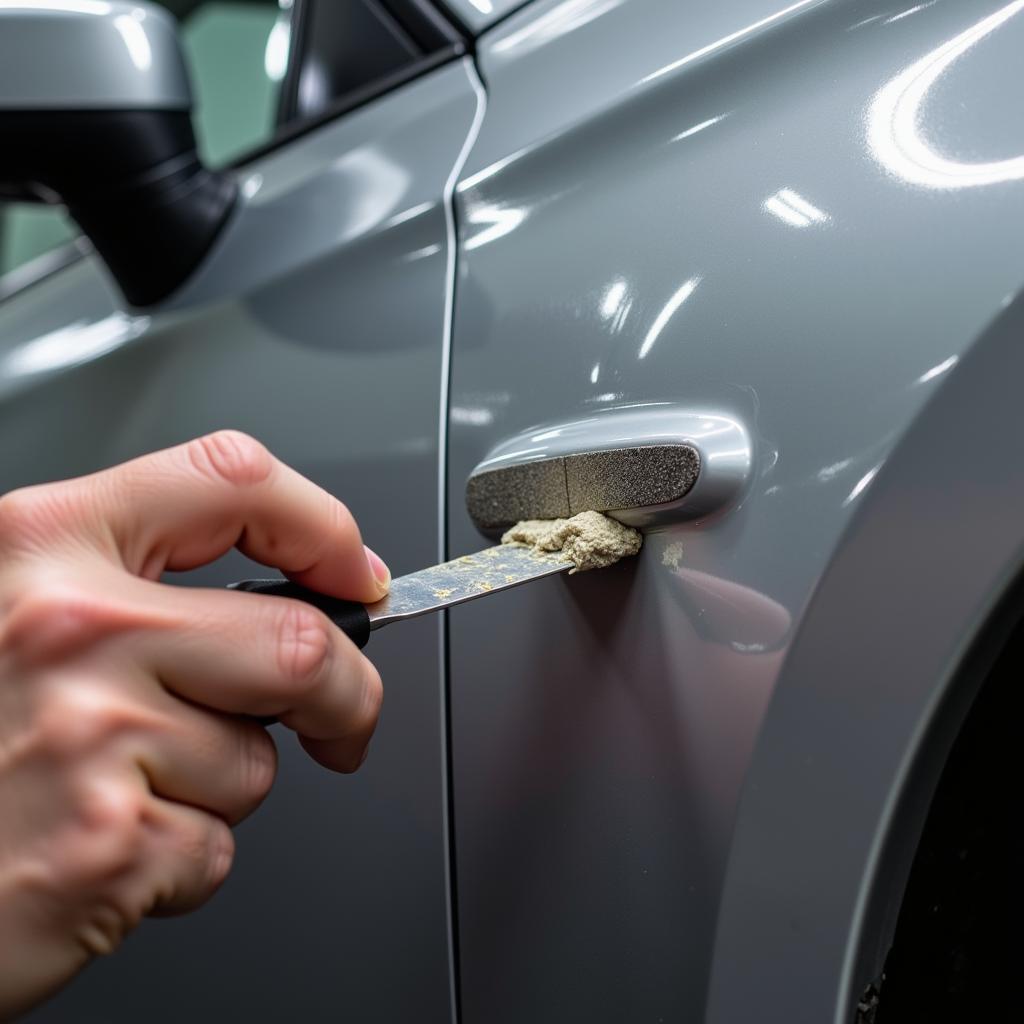Car body repair filling a hole is a common procedure in auto body shops. Whether it’s a small ding from a rogue shopping cart or more significant damage from a collision, knowing how to effectively repair these holes is crucial for maintaining a vehicle’s appearance and structural integrity. This article will guide you through the process, offering expert advice and practical tips.
Understanding the Repair Process
Before diving into the how-to, it’s essential to understand the different types of damage and the appropriate repair methods. Minor dents and dings often only require body filler and some sanding. However, larger holes or those involving structural damage might necessitate welding or patching before filling. Choosing the right approach is crucial for a long-lasting repair. For smaller repairs, check out our guide on car body kit repair.
Assessing the Damage
Properly assessing the damage is the first step in any car body repair. This involves carefully examining the hole’s size, depth, and location. Is the metal surrounding the hole rusted or weakened? Is there any underlying structural damage? Answering these questions will help you determine the necessary repair steps.
Materials and Tools You’ll Need
Having the right tools and materials is vital for a successful car body repair. Here’s a checklist:
- Body filler (also known as Bondo)
- Hardener
- Mixing board and spreader
- Sandpaper (various grits)
- Safety glasses and gloves
- Primer
- Paint that matches your car’s finish
- Clean cloths
- Masking tape and paper
For more complex bodywork, you might be interested in learning about car body repair welding mig tig or arc.
Step-by-Step Guide to Filling a Hole
- Clean the area: Thoroughly clean the area around the hole with a degreaser and remove any loose rust or paint. This ensures proper adhesion of the body filler.
- Prepare the filler: Mix the body filler and hardener according to the manufacturer’s instructions. Work quickly, as the mixture hardens relatively fast.
- Apply the filler: Using a spreader, apply the filler to the hole, ensuring it fills the cavity completely and overlaps the surrounding metal slightly.
- Sanding: Once the filler has cured, sand the area using progressively finer grits of sandpaper until smooth and flush with the surrounding surface.
- Prime and paint: Apply primer to the repaired area, followed by several coats of paint that matches your car’s finish.
When to Call a Professional
While small repairs can often be handled DIY, more extensive damage or those involving structural components are best left to the professionals. If you’re unsure, consult a qualified car body repair technician. They have the expertise and equipment to handle complex repairs effectively. Thinking about the costs involved? Check out our resource on car body work repair cost uk. You can also explore options for combined repairs in our article on car body and alloy wheel repair. For specific concerns regarding aluminum car bodies, we have a dedicated article on aluminum car body corrosion repair.
“A properly filled hole is virtually undetectable once painted,” says John Smith, Senior Auto Body Technician at Smith’s Auto Repair. “The key lies in meticulous preparation and application.” Another expert, Jane Doe, Lead Technician at Doe’s Body Shop adds, “Don’t rush the sanding process. Patience is key to a flawless finish.”
Conclusion
Car body repair filling a hole can be a straightforward process if tackled correctly. By following the steps outlined in this guide and using the right materials, you can restore your car’s appearance and maintain its value. Remember, proper preparation and patience are crucial for achieving professional-looking results.
FAQ
- What type of filler should I use? Two-part epoxy fillers are generally recommended for car body repairs due to their strength and durability.
- How long does the filler take to dry? Drying times vary depending on the product and temperature, but most fillers cure within 30-60 minutes.
- Can I fill a hole in plastic bumper? Yes, but you’ll need a specific type of plastic filler designed for bumpers.
- What if the hole is rusted? Remove all rust before applying filler. A rust converter can help neutralize any remaining rust.
- Do I need to prime before painting? Yes, primer is essential for proper paint adhesion and a smooth finish.
6.. What if the hole is too big to fill? A large hole may require patching or welding before filler can be applied. Consult a professional for advice. - How can I prevent future holes? Regular maintenance, careful parking, and promptly addressing minor dings can help prevent larger holes from forming.
Common Car Body Repair Scenarios
- Small dents and dings: These are often caused by minor impacts like shopping carts or door dings.
- Rust holes: Rust can weaken the metal and create holes, especially in older vehicles.
- Collision damage: Accidents can cause significant holes and damage to the car body.
Related Articles
Consider checking out our other helpful articles on car repair topics.
Need Help?
Contact us via WhatsApp: +1(641)206-8880 or Email: [email protected] for 24/7 support.


